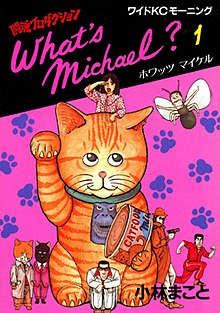Loading AI tools
Manga From Wikipedia, the free encyclopedia
What's Michael? (ホワッツマイケル?, Howattsu Maikeru?) is a Japanese manga series created by Makoto Kobayashi. In 1984, it began its serialization in the Weekly Morning magazine. The manga shows Michael, an orange American Shorthair tabby cat, his feline friends, and other domesticated pets in a series of humorous episodes. Michael is not a specific cat, but rather a feline version of the everyman as he appeared in drastically different settings across chapters: he's a normal cat in some chapters (with different owners in different chapters), an anthropomorphic cat in others, and he even dies in some chapters.
| What's Michael? | |
 First tankōbon volume cover | |
| ホワッツマイケル? (Howattsu Maikeru?) | |
|---|---|
| Manga | |
| Written by | Makoto Kobayashi |
| Published by | Kodansha |
| English publisher | |
| Magazine | Weekly Morning |
| English magazine | |
| Demographic | Seinen |
| Original run | 1984 – 1989 |
| Volumes | 9 |
| Original video animation | |
| Studio | Kitty Films |
| Released | 25 November 1985 – 25 July 1988 |
| Runtime | 55 - 60 minutes |
| Episodes | 2 |
| Anime television series | |
| Written by | Satoru Akahori |
| Music by | Kōji Makaino Michiaki Katō |
| Studio | Various[lower-alpha 1] |
| Original network | TV Tokyo |
| Original run | 15 April 1988 – 28 March 1989 |
| Episodes | 45 |
Dark Horse Comics released the series in the US as eleven volumes between 1997 and 2006, and in 2020 released the first volume of a "Fatcat Collection", which spanned the first six volumes.[1][2][3][4][5][6][7][8][9][10][11][12][13] The manga was presented in the standard left to right American reading format, by Dark Horse, with the artwork flipped to change the reading style.
In 1986, What's Michael? received the Kodansha Manga Award for general manga.[14]
The manga was adapted into two anime OVA films in 1985 and 1988, and a 45-episode TV series in 1988–1989.
Most episodes of the series fall into one of two kinds of stories. The first portrays the cats in a realistic way, living out normal lives with their owners. It finds humor in how humans observe their pets' naturally quirky behavior. The second type of story is complete fantasy in which all the animals are given anthropomorphic characteristics such as walking on two legs, wearing clothes, and being able to talk to each other; these episodes place the animals in a storyline that mixes up their human personae with normal animal behavior.
| No. | Release date | ISBN | |
|---|---|---|---|
| 1 | 18 January 1985 | 4-06-176507-8 | |
| |||
Seamless Wikipedia browsing. On steroids.
Every time you click a link to Wikipedia, Wiktionary or Wikiquote in your browser's search results, it will show the modern Wikiwand interface.
Wikiwand extension is a five stars, simple, with minimum permission required to keep your browsing private, safe and transparent.